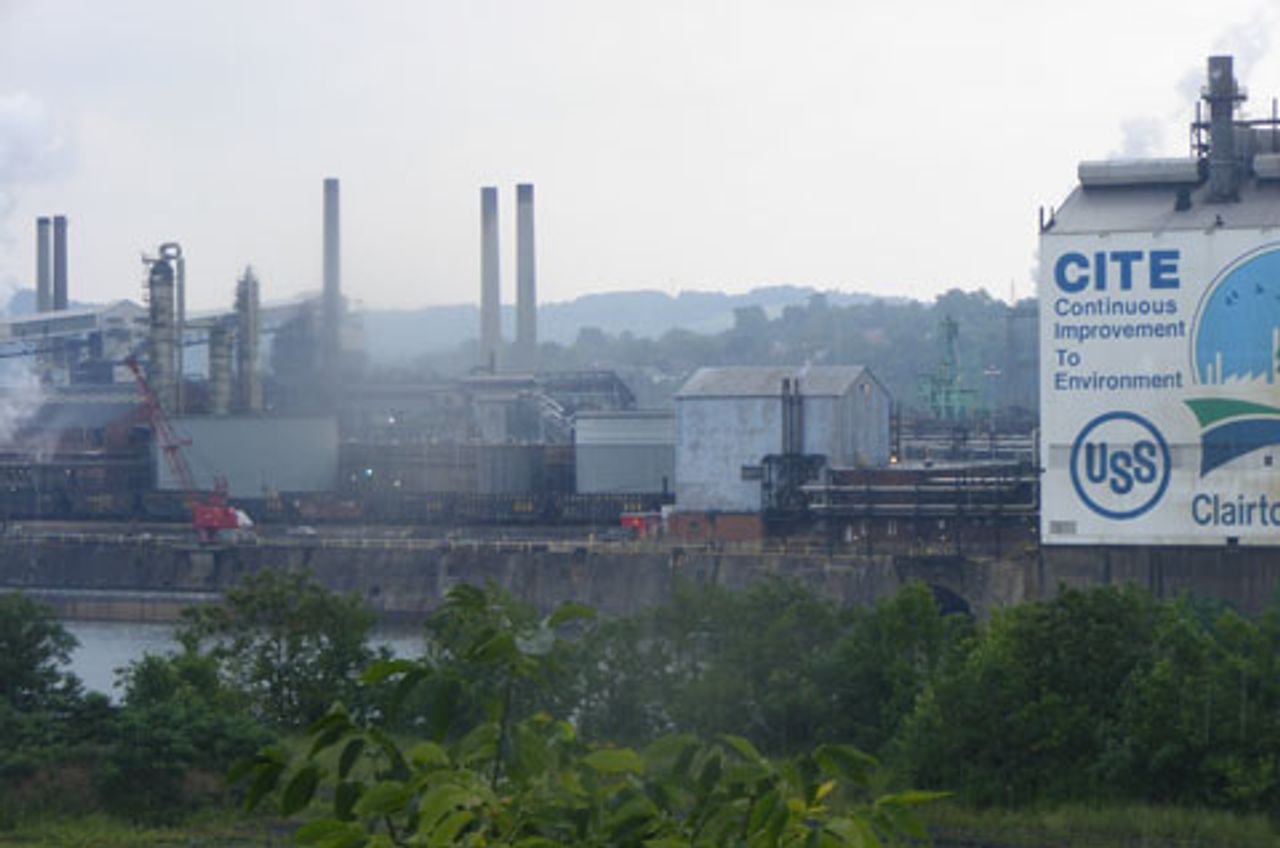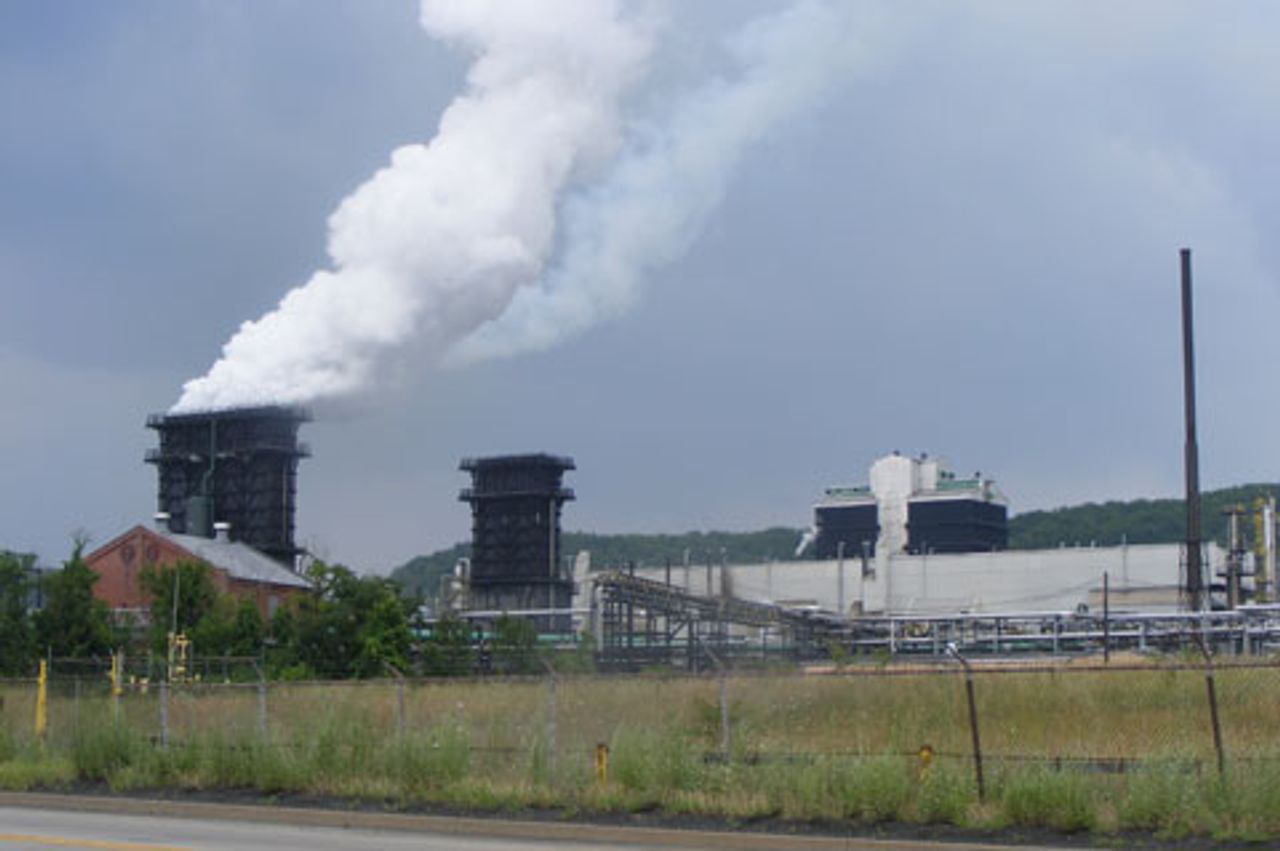 A section of US Steel Clairton's mill near the site of Wednesday explosion is seen from across the Monongahela River
A section of US Steel Clairton's mill near the site of Wednesday explosion is seen from across the Monongahela RiverNine workers remain hospitalized Friday, four in critical condition with burns over 10 to 40 percent of their bodies, as the result of an explosion and fire Wednesday morning at US Steel’s Clairton coke works, in the Pittsburgh, Pennsylvania, area.
In total, 20 workers were injured in the blast that occurred at 9:30 a.m. Wednesday in Clairton’s B batteries. Workers were performing maintenance work when fumes from the coke battery ignited. The force of the explosion twisted steel beams and blasted down block walls. Parts of walls and pipes were strewn over a wide area. It took fire crews until nearly 3 p.m. to extinguish the resulting blaze.
Workers standing a few feet from the explosion site were enveloped in a fireball, Allegheny County’s Emergency Management Chief Robert Full said. The workers wear fireproof clothing, boots and hardhats on the job. Official say that some of the fireproof uniforms were burnt through.
Three workers were taken to the burn unit at West Penn Hospital, one by air; they are suffering from severe burns to the head, neck and face. Six of the injured were taken to UPMC Mercy with burns to their faces and extremities. Six others were taken to UPMC Presbyterian and one is being treated at UPMC McKeesport.
Two of those at West Penn Hospital remain in critical condition; both men have burns to their airways. Two of those at UPMC Mercy hospital burn unit remain in critical condition as well. Doctors at both hospitals expect the men to survive.
Fourteen of the injured workers work for US Steel, the other six for contractors—five of them are employed by Power Piping and are members of the steamfitters union.
The US Steel facility is located in Clairton, Pennsylvania, on more than 390 acres along the Monongahela River, 20 miles south of Pittsburgh. It is the largest coke producer in the country. According to the company’s website, the operation produces 4.7 million tons of coke a year and employs about 1,500 workers.
 Another part of US Steel Clairton Works
Another part of US Steel Clairton WorksCoke is produced by baking coal in ovens to 2,000 degrees Celsius to burn out all the impurities. The result is then used in the production of steel. A string of ovens is called a battery. The Clairton works has 12 batteries. The B battery is the largest, made up of 75 coke ovens.
US Steel both uses the coke in its own steel mills and sells it to other steelmakers. In addition to the coke, gases and many other chemicals are produced in the coke-making process. The Clairton works captures most of those gases and chemicals and reuses or sells them.
It is believed that gas leaking from one of the gas lines in the B Battery ignited Wednesday causing the powerful blast and fire. Investigators are trying to determine what ignited the gas.
Brian Doyle, one of the injured steamfitters, told a local television station that his gas detector was sounding the alarm, but that the crew remained inside trying to seal the leaking pipe.
“I just saw like a wind tunnel come at me and just the loudest boom I’ve ever heard,” Doyle told KDKA television.
“It shot me across the floor—in the air across the floor,” he said. “A beam came down, hit me.”
Brian’s cousin, Richard Doyle, was also injured in the explosion. He is in critical condition, in UPMC-Mercy hospital with burns over 40 percent of his body. He is currently in a drug-induced coma. Doctors often place burn victims in such comas as the only way of controlling the pain, as the body needs time to heal.
A similar explosion occurred at the mill in September, which killed one worker and critically injured another. Nicholas Revetta, 32, also of Power Piping of Pittsburgh, was 32 and married with two young children
“When you’re out and you see all the ambulances flying past, thoughts do come back of my husband,” Maureen Revetta told Channel 11 news.
“They had just walked into the gas exchange area a couple minutes before the explosion occurred,” said Revetta, speaking of the accident that killed her husband last year.
She said that she was speaking out because she did not want to see more workers injured or killed. “I think I was looking more to OSHA [Occupational Safety and Health Administration] to do that for me because I thought that was their job, to provide an explanation as to what happened and to make the workplace safe for the men that have to go there every day,” she said. “I just really feel for the families of the men who were injured.”
A steelworker coming off the day shift after the explosion Wednesday asked the WSWS not to use his name. “We don’t really know what happened. They told us around 9:30 about the blast and fire, but then for us to continue working. I work in the C control room, that’s where a person was killed in September.
“US Steel hires contractors to perform much of the maintenance work, they are all over the mill. It saves US Steel money, but the contractors don’t know the mill the way people who have been working there their whole lives do. The contracting firms just want their men to get in, get the job done and get out.”
A spokesperson for US Steel said that production had been resumed in much of the B battery, and that it should be fully brought back online within a week. Production in the rest of the mill never stopped.
OSHA indicated that it was investigating the source of the blast Wednesday. However, the agency closed the investigation into September’s explosion without ever finding a cause, and the company has not been fined. While OSHA officials said they could not comment on the recent accident, they did say it was not related to September’s explosion, because they took place in different batteries.
According to government documents, OSHA has fined US Steel’s Clairton works only minimal amounts in the past. In 2006 a workers lost both his legs when he was struck by a piece of equipment. The company was fined just $7,000 for the incident. In 2004, the company was fined $3,400 after a worker was seriously injured in a train accident.
For its part, the United Steelworkers, the bargaining agent for workers at the Clairton mill, is also defending the company. Like OSHA officials, USW officials refused to comment about Wednesday’s explosion, saying that they do not comment on on-going investigations. Wayne Ranick, a USW spokesman, said that the union would wait “for the conclusion of the investigations and the hearing of the findings before making any additional comment.”
“The investigation is under way,” Ranick said in Pittsburgh Thursday. “It has been under way for a while. It does take them time. There’s a lot of diligence going on. We expect it to take some time because it is a comprehensive process. Both union and company safety officials are participating, as is OSHA.”
The USW did not demand that its workers be withdrawn from the mill Wednesday to allow investigators to determine whether it was safe to continue working. The union went along with company officials, assuring workers it was safe to work in nearby buildings. Emphasizing the danger that might still exist, government investigators did not enter the B battery until Friday out of fear of remaining gas and structural damage to the building.
In April 2009, US Steel put on hold a $1.2 billion capital improvement project at its Clairton works because of a drop in steel demand as a result of the global slump. The company had broke ground on the project the previous October just as the economic crisis was taking hold. US Steel has been hard hit by falling demand. It is a major supplier for the auto and appliance industries, which saw sales collapse in 2008-09. US Steel is also a major exporter of steel to China to meet its expanding demand for steel used in construction. The firm’s stock had climbed to a high of $180 a share in June 2008, but has fallen to less than $50 a share.
Clairton suffered tremendously from the collapse of the steel industry in the 1980s and remains a depressed community of 7,800 residents. The median income is about $26,000, or half of the national average. Only a small number of residents work in the mill, and the company uses few local contractors or suppliers.
Subscribe to the IWA-RFC Newsletter
Get email updates on workers’ struggles and a global perspective from the International Workers Alliance of Rank-and-File Committees.
